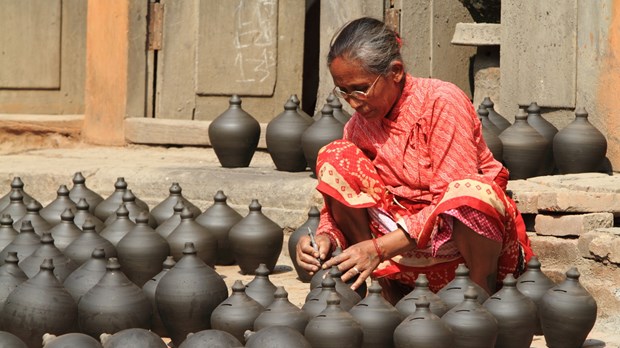The Immigrant Next Door

This past May, new believers were baptized into the body of Christ at my church. Anita (not her real name), a Nepali-speaking Bhutanese refugee in her eighties, was one of them. The service was officiated by our associate pastor and by the minister to the Nepali-speaking community, who took turns proclaiming, “Praise be to our Lord Jesus!” in English and in Nepali, “Hamra Pravu Yeshu lae prashamsha hos!”
When it was Anita’s turn, she was carefully helped into the pool. But as the Nepali-speaking minister tried to help her cross her arms over her chest, she resisted slightly. He spoke to her in Nepali. She responded. Then her minister shouted to the congregation: “She wants to bow to Jesus before she is baptized!” She put her palms together at her chest and bowed reverently, amid an expectant silence. Then, suddenly, the entire congregation was on their feet applauding, shouting, “Amen!” and proclaiming the goodness of the God of all nations.
Before the advent of globalization, mission activity tended to be seen as a one-way street that flowed through only a few conduits. In fact, sharing the Good News with those outside our cultural context—most likely somewhere else—has been one of the main earmarks of what it means to be “Evangelical.” This call to “” has not gone away, but our understanding of it has shifted; massive changes wrought by recent technological advances have created opportunities for cross-cultural evangelism in cities that would have been nearly mono-cultural only a generation or two ago. The face of global evangelism has changed, increasing our opportunities to share the gospel with the world in word and deed, right in our own communities.
The World Among Us
One prominent way Christian women are reaching out in this new context is through involvement with refugees like Anita. Last year, the United States received 70,000 refugees—just a small segment of the 16.7 million people forced to leave their homelands every year because of persecution, war, or violence. These refugees were resettled to 46 states with the largest numbers going to California (3,068), Michigan (2,753), and Texas (2,462). Canada, with a population roughly equal to California, resettled 23,056 refugees in 2012.
Refugees often arrive in North America in great physical and spiritual need. Some have lived or even grown up in refugee camps where they’ve experienced malnutrition. Others are fleeing violence. Most don’t speak English and experience significant culture shock upon moving here. Many have suffered from traumatic events and life circumstances that have led them to begin asking faith questions within whatever religious context they come from (often not Christianity). The good news is churches and individuals are recognizing these needs and serving these communities and individuals by providing assistance to whole-person needs: physical, educational, and spiritual.
Welcoming the Stranger
“Before I came here I had a very different view of Christians.”
“I never would have hung out with people who are a different nationality.”
These are some comments Emily Parsons Dickau heard from refugees at Kinbrace, a faith-based refugee housing and support nonprofit in Vancouver, British Columbia.
For many refugees, landing in a new country is only the first of many steps toward finding a new home. In Canada, refugee claimants must appear before an immigration and refugee board and provide evidence that they are, indeed, refugees. Because there is little affordable housing in Vancouver, many refugees would quickly become homeless without the help of churches or nonprofits.
Kinbrace, which began in 1998 as a ministry of Grandview Calvary Baptist Church, has welcomed many refugees as they have begun their journey in a new place. People come to Kinbrace at the beginning of the process of seeking refugee status; they need a safe place while they wait. Kinbrace assists by housing claimants within an intentional community (several Kinbrace staff are permanent residents of the two homes) as well as by equipping them for their hearings through their READY Tour program. Any refugee claimants may join the READY Tour (in which they tour a refugee hearing room, meet refugee protection division staff, and learn more details about the hearing process). Kinbrace also provides a Refugee Hearing Preparation Guide (currently available in four languages) to help ease the challenge of red tape and government forms in a foreign country.
In my conversation with Emily, who has worked with Kinbrace for four years as the community-building and education coordinator, she repeatedly referenced biblical injunctions to welcome the stranger and to provide for their physical needs in addition to creating and developing deep relationships. For example, Leviticus 19:34 says, “The foreigner residing among you must be treated as your native-born. Love them as yourself, for you were foreigners in Egypt” (NIV).
Welcoming someone involves more than simply providing housing. It includes creating opportunities for relational growth and fellowship, and this is part of Emily’s work. She organizes community events that provide opportunities for people to come together and build relationships: weekly shared meals and game nights, Thanksgiving dinner, decorating for Christmas. “I’m seeing more of the diversity and the fullness of God through the diversity of community in Kinbrace,” Emily shares.
When asked about how people can get involved in this type of ministry, Emily immediately reframes the question. “I think that the question of ‘How can I be involved?’ can feel so task oriented.” But, as she elaborates, it’s not a task. “As Christians, it’s an invitation, a reminder to what we’ve already been called to do: to welcome the stranger and the foreigner, those different than us. It’s not just a call for volunteers—it’s a call of the gospel.”
Opening Eyes
About ten years ago, Dawn Waltz’s congregation (Faith Church in Indianapolis, Indiana) realized an opportunity for cross-cultural mission was emerging in Nora, their church’s northern Indianapolis neighborhood. Nora’s pairing of readily available low-skill jobs with a school district offering numerous ESL classes for children was the perfect combination for refugee placement—and the community was becoming home to refugees from all over the world.
Laypersons recognized the opportunity first. Dawn elaborates, “There were a few people who said, ‘You know what, there are people in our neighborhood we could minister to by helping them with their English. Do we have some room available?’” The church’s first English classes started several nights a week, a couple of hours a night. Initially there were about 16 volunteers and 28 students.
Dawn volunteered the first year, and by the second year, word of mouth had gotten around in the neighborhood that there was a church on the corner teaching English. During the second year of the program, Dawn asked if she could help with administration. This project was close to Dawn’s heart, and by the end of the year, she and her husband took a leap of faith and agreed she would quit her paid work for this volunteer position. A month later, Dawn’s husband received a raise that covered what she had been earning.
The church now teaches students (refugees and immigrants) from more than 30 countries. Classes meet once a week and include 188 adult students and 147 children as well as a church volunteer staff of more than 80 people.
Learning English is the primary challenge new arrivals to the United States face. “Even though they get a lot of assistance at the beginning, that assistance dries up pretty quickly, so they have to be on their feet within nine months to a year,” Dawn explains. “They have to have enough English to make it.” Another significant challenge for many is the contrast of the refugees’ monocultural background with their new, multicultural neighborhood in Nora. The diversity of the English classes provides a safe place for people to get to know their neighbors from other countries and cultural backgrounds. Participants in the program regularly comment, “This is the only place where people smile at me and are kind to me.”
“When I first started, I thought I had something to share, and I’m telling you right now that as I’m working I realize I have so much to learn,” Dawn reflects. Through this work, she’s been changed: “My eyes are open, my heart is open. I’m not afraid to start up a conversation with someone who doesn’t look like me.”
Many of us live in cities or communities whose cultural and ethnic diversity is rapidly changing. Though we may not all work or volunteer at an ESL program, if we open our eyes, we may find opportunities to visit with a parent at the playground, or chat with a veiled woman in line at the grocery store. How might God open your eyes for opportunities to welcome others?
Effecting Hope
Patty Decker has always been drawn to people different from herself. So, in 2008, when Thornapple Covenant Church (Grand Rapids, Michigan) began assisting with refugee resettlement through Bethany Christian Services, Patty would often join the Nepali-speaking Sunday school class. “I had no idea what was being said because it was in Nepali, but I would pray and soak up the people and try to converse with them.”
About three years later, when the church’s leadership determined they needed a staff person to help coordinate the Nepali-speaking ministry, Patty began her work of connecting, communicating, and building community. The Nepali-speaking community is “like a little church within a church,” and Patty works closely with Ram Aryal, the minister to the Nepali-speaking community (who joined the staff in 2013) to help this refugee congregation successfully transition to a new land.
Patty, Ram, congregants, and church leadership are committed to prayer—and God hears. “We are constantly amazed at how God is working in ways that we would never have imagined. God is answering prayers that we didn’t even know to pray, in ways that we never could have imagined. Who would have thought that an 80something-year-old grandma would be baptized? And that the ripples of that would be having such large effects on people’s lives? We were focusing on the 25-year-olds, the 30-year-olds—they’re the center of the community. And then God just said, ‘Nope, that’s not what I was thinking.’ God is in control, working in mysterious ways.”
Relationships with Nepali-speaking refugees have changed the perspective of many volunteers. “The Nepalese are so grateful—they just feel like life is so good. We’ll talk about how things are really hard, and they’ll say, ‘No, things are not hard here. We lived in a refugee camp, we were suffering, we had no future, we had no hope.’ And here they are in this tiny little apartment with barely what they need, always trying to get enough work,” Patty says.
One of Patty’s great joys has been hearing Nepali-speaking youth discuss their plans for the future. “We were talking about being American now, having some money and maybe becoming successful, and one said, ‘I want to have some money so that I can help other people.’ Another responded, ‘Yeah, I’m going to go to India because there are so many people hurting there. I can really help out.’ And the third boy replied, ‘No, I’m going to stay in the United States because there are poor people here who need me, and I have been given a whole new opportunity in life in America. I want to help people here.’”
Patty, like Dawn and Emily, recognizes the importance of keeping one’s eyes open to the needs surrounding us. She invites us to look around, see what we can do, and offer to help: “Everybody has a gift that they can use.”
Pray about how God might want to use you. “Having a posture of prayer is important,” Emily urges. “Pray for compassionate policies, for our governments, countries, communities, and homes to be welcoming. Pray for the complex systems that exist in the world—pray for people who are being forced to flee to unknown places and find a way forward.”
Where is the world right next door in your own community? How might God be inviting you to re-imagine global missions, evangelism, and discipleship by ministering to immigrants and refugees in your city or neighborhood? May we be women who keep our eyes open, not merely for tasks to cross off our lists of good deeds, but instead as a natural response to the gospel of Christ, which compels us to the stranger and foreigner.
Joy-Elizabeth Lawrence is a TCW regular contributor. A writer and performer who specializes in biblical storytelling, Joy is the mother of two children and lives with her family in Grand Rapids, Michigan. She can be found at PathlightStories.com.
Read more articles that highlight writing by Christian women at ChristianityToday.com/Women
 Read These Next
Read These Next

 Visiting Africa Upended My View of AdoptionThe importance of building home-grown families
Visiting Africa Upended My View of AdoptionThe importance of building home-grown families Daughters in DarknessPsychologist Diane Langberg is shining a light on the sexual slave trade—and you can, too.
Daughters in DarknessPsychologist Diane Langberg is shining a light on the sexual slave trade—and you can, too.
 Moms, Those Children Are Not YoursWhy you have permission to stop worrying
Moms, Those Children Are Not YoursWhy you have permission to stop worrying








 Homepage
Homepage
